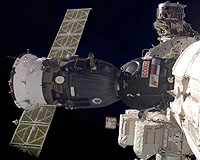 |
Paris, France (ESA) Jun 01, 2009 The crew of the International Space Station has increased to six for the first time with the arrival of three new residents including ESA astronaut Frank De Winne with the Soyuz TMA-15 spacecraft. The Soyuz TMA-15 docked with the International Space Station at 14:34 CEST (12:34 UT). After leak checks, the hatches between the two spacecraft were opened at 16:14 CEST (14:14 UT). The new crewmembers, ESA astronaut Frank De Winne, Russian cosmonaut Roman Romanenko and Canadian Space Agency astronaut Robert Thirsk, were welcomed on the ISS by the three Expedition crewmembers already in residence: Russian cosmonaut Gennady Padalka, NASA astronaut Michael Barratt and Japanese astronaut Koichi Wakata. Together they will form the first ever six-person ISS crew - Expedition 20. With the Expedition 20 crew now together on the ISS, it is also the first time that all five ISS partners are represented by astronauts on the Station at the same time. "This is a very exciting moment for the ISS Partners and a major milestone for human spaceflight and exploration. With Frank, Roman and Bob now together with the other three ISS crewmembers, we reach a full six-crew capability on the Station. We have had a very intense two weeks in Europe: the roll out of the Node 3, the selection of six new members of the European Astronaut Corps and now this milestone," said Simonetta Di Pippo, ESA Director of Human Spaceflight. "This opens up new and exciting opportunities on the utilisation of the Station for scientific and research activities but also in preparation for future exploration missions to more distant destinations." De Winne, Romanenko and Thirsk will spend the next six months on the Station. For the first four months of their stay, De Winne will be a Flight Engineer as a member of the Expedition 20 crew, reporting to Expedition 20 Commander Gennady Padalka. With a rotation of three of the six crewmembers due in October, De Winne will take over as Commander of the Expedition 21 crew until his return to Earth in November. He is the first European to take on this role. During his mission, called OasISS, De Winne will use the scientific facilities of the ISS, especially the European Columbus laboratory, to undertake a European programme of scientific experiments and technology demonstrations. These come predominantly from scientific institutions across Europe and include experiments in human physiology, biology, radiation dosimetry, exobiology, fluid physics and materials sciences. ESA views education as a valuable aspect of its human spaceflight missions, helping to inspire the youth of today. As such, the OasISS mission will be the prime focus of ESA's education activities during the mission, including a live lesson given by De Winne from the ISS. The Expedition 20 crew will hold their first news conference on Monday 1 June at 16:25 CEST (14:25 UT). Share This Article With Planet Earth
Related Links OasISS Station at NASA Station and More at Roscosmos S.P. Korolev RSC Energia Watch NASA TV via Space.TV Space Station News at Space-Travel.Com
 Space station crew doubles to six for first time
Space station crew doubles to six for first timeMoscow (AFP) May 29, 2009 Three new astronauts boarded the International Space Station (ISS) Friday from a Russian space capsule, doubling its permanent crew to six for the first time in its history. The Soyuz space capsule carrying astronauts from Canada, Belgium and Russia on Friday automatically docked with the ISS at 4:34 pm Moscow time (1234 GMT), mission control in Korolyev outside Moscow said. Belgian Fran ... read more |
|
| The content herein, unless otherwise known to be public domain, are Copyright 1995-2009 - SpaceDaily. AFP and UPI Wire Stories are copyright Agence France-Presse and United Press International. ESA Portal Reports are copyright European Space Agency. All NASA sourced material is public domain. Additional copyrights may apply in whole or part to other bona fide parties. Advertising does not imply endorsement,agreement or approval of any opinions, statements or information provided by SpaceDaily on any Web page published or hosted by SpaceDaily. Privacy Statement |